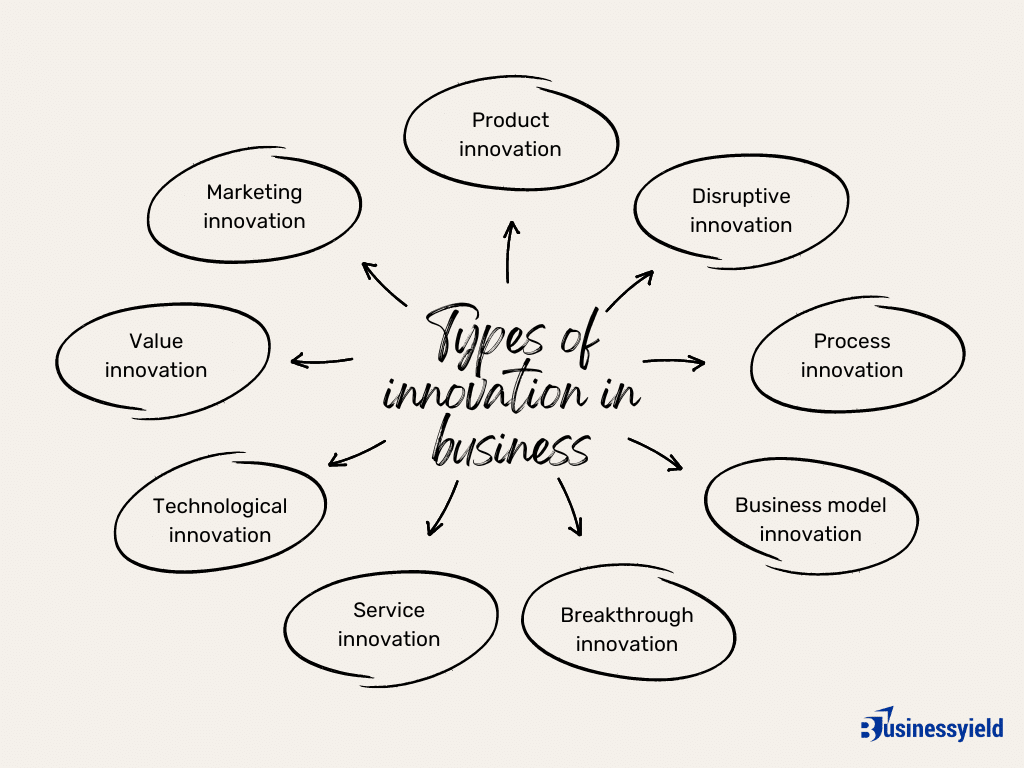If you want your business to stand out, then you must be willing to adopt innovation in line with your business strategy. Whether you’re an entrepreneur kickstarting your business, a small business owner seeking growth, or a business leader in a larger corporation eyeing enhanced competitiveness, business innovation comes with a lot of transformative rewards, both during a crisis and in its aftermath.
In the world of business, strategic innovation has taken center stage as a fundamental catalyst for success. Thanks to dynamic market conditions and the swift progress of technology, companies must perpetually adjust and introduce innovation to stay ahead of the competition. Within this dynamic environment, the domain of innovation provides an expansive and limitless vista, offering a multitude of prospects that encompass the inception of fresh products and services and the crafting of digital business models.
These prospects are virtually boundless, establishing innovation as a foundational element of business strategy.
Key takeaways
Business innovation is the process through which an individual or organization creates or reimagines products, processes, and concepts.
Innovation is essential for fostering growth, maintaining competitive advantage, and driving social progress.
Prioritizing innovation is one way a business can benefit from the ever-changing market trends.
Understanding the different forms that innovation can take and what this can look like may help you create and integrate it into your areas of responsibility.
What is innovation?
In short, innovation is doing something different to create value. Business innovation refers to the process of introducing new ideas, methods, products, or services that result in significant improvements or advancements within an organization.
Innovation often involves transforming creative ideas into new solutions that drive business growth, improve efficiency, and meet customers’ changing needs. It does this while improving decision-making and problem-solving across the organization.
Examples of innovation include Google’s introduction of a search engine in 1998 and Tesla’s commitment to putting the first electric vehicle on the road in 2008. Neither of these concepts had been heard of at the time and represented a major paradigm shift.
Now, we don’t expect your business to innovate at the same level, but that doesn’t subtract from the importance of innovation in today’s world. Not only does it offer the potential for increased profit, but it can also create new jobs and increase customer trust. Your brand may develop better public recognition, and current workers may discover increased efficiency or productivity.
Types of innovation in business
Product innovation
Product innovation involves the development of a new product or the enhancement of an existing one. This is done strategically to address customers’ needs uniquely and innovatively.
The process of product innovation involves generating and exploring ideas that challenge the status quo, encouraging creativity. It also involves discovering solutions that have the potential to revolutionize industries and capture the imagination of consumers. Through these forward-thinking endeavors, product innovation truly comes to life. It shapes the landscape of markets and paves the way for transformative advancements.
Examples of successful innovative products include the introduction of electric cars, smart home technologies, and advancements in medical devices.
Disruptive innovation
Disruptive innovation involves technologies used to make products easier to use or access and available to a larger, non-targeted market. Note that it does not involve the process of improving or enhancing products for the same target market. An example of disruptive innovation is the introduction of digital music downloads, which have, by far, replaced compact discs.
Clayton Christensen popularized the idea of disruptive innovation in the book The Innovator’s Solution, which was a follow-up to The Innovator’s Dilemma published in 1997.
Investing in a disruptive innovation can be complicated. It requires an investor to focus on how companies will adapt to disruptive technology instead of focusing on the development of the technology itself.
Process innovation
Process innovation involves creating and implementing new or improved processes with enhanced capabilities, functionalities, or efficiencies. It focuses on finding better ways to do things, offering useful improvements over previous methods.
A business process analyst or specialist can create or adopt a range of processes that help transform a business’s raw materials and use different skills, equipment, and technology. You may consider using process innovation to improve your product or service production and delivery to make them more efficient and cost-effective. This innovation may relate to product manufacturing or include improving secondary or supporting business processes.
You can also facilitate process innovation by integrating innovative technologies or methods of operation.
Business model innovation
Business model innovation empowers companies to distinguish themselves from competitors through the provision of distinctive value propositions, exploration of uncharted market segments, or harnessing emerging technological advancements.
You can benefit from business model innovation to address specific challenges by changing how your business functions and makes money. It also involves changing what customers you target, how you target them, and what you use to target them. This type of innovation also involves changing how your company adds value and what type of decisions you make.
Integrating business model innovation can involve taking calculated risks. It’s also a good way to keep up with trends, manage market saturation or address fluctuating profit margins.
Breakthrough innovation
Breakthrough innovation refers to an internal innovation within a company that propels a product, service, or strategy to a higher level. It not only expands the company’s presence into new markets but also fundamentally alters the dynamics of how customers engage with the market or industry.
This transformative process, occurring within the company, often results in a significant shift in market perception and customer interaction.

Service innovation
Service innovation involves developing and implementing new and existing innovative ideas and solutions for improved services. This form of innovation may provide a valuable way to differentiate a business from its competitors. It addresses customer problems, enhances customer experiences, and improves the overall quality and value of services.
Companies like Netflix, Uber, and Amazon Prime showcase innovative services that have transformed their respective industries.
Technological innovation
Technology innovation is about creating or improving technologies for enhanced capabilities. It requires substantial investment in research and development, adaptability to market trends, and a focus on delivering value. Success hinges on effective management of intellectual property, talent, and partnerships.
Technological innovation is relevant to business analysts, project managers or systems experts. Integrating new and improved automated technology, software or machinery or enabling more affordable and efficient processes can reduce product variability and improve quality.
Delivering value is the ultimate goal of technology innovation. Whether it’s enhancing efficiency, improving user experiences, or solving complex problems, innovative technology aims to make a positive impact. This focus on value creation is what drives the adoption of new technologies and positions them as drivers of progress.
Value innovation
Value innovation is about creating a unique value proposition. It involves creating new or improved products, services, or business models that deliver unique value to customers while simultaneously reducing costs.
Marketing innovation
Marketing innovation can expose a product or service to a new market or increase current market share by alerting more customers to what a company offers. It may help a business better connect and engage with new customers by finding new uses for an existing product or highlighting qualities that customers might not be aware of.
An example of this is a menswear boutique that specializes in designing and creating bespoke tuxedos for male grooms. The boutique may expand its market base by advertising its services to women or non-binary individuals who may prefer to wear a suit to their wedding.
Organizational innovation
Organizational innovation entails creating and adopting new organizational structures, processes, and practices to enhance the efficiency, effectiveness, and sustainability of businesses. It involves reimagining conventional approaches, embracing emerging technologies and systems, and fostering a culture of innovation within the organization.
Social innovation involves developing and implementing new ideas, strategies, and solutions that address societal challenges and improve the well-being of communities. It goes beyond traditional approaches, seeking novel ways to tackle social issues such as poverty, inequality, healthcare, and environmental sustainability.
Social innovation focuses on finding new, sustainable, and inclusive solutions that address the root causes of social problems and lead to positive societal change. It often involves collaboration between various stakeholders, including governments, businesses, non-profits, and communities, to create a positive and lasting social impact.
Here’s a checklist outlining the steps you can follow to adopt innovation in your business:
BusinessYield innovation
Benefits of adopting innovation in business
While this isn’t an exhaustive list, I want to give you a good idea of how innovation can impact your organization. These include:
- Gain a competitive advantage. Innovation can help you develop unique products and services that set you apart from competitors. Over 80% of digitally mature companies cite innovation as one of their core strengths.
- Meet customer demands. 65% of fast-growing companies say they collaborate with their customers on potential innovations. Businesses that try to better understand and respond to customer needs through ongoing innovation do a better job attracting new customers and retaining existing clients.
- Increase efficiency and productivity. Innovation can result in increased productivity as you find ways to improve existing processes, streamline operations, and implement new forms of technology.
- Drive business growth. You’ll position your company to better identify and seize new opportunities. You may also create opportunities to diversify revenue streams or expand into new markets.
- Better equipped to deal with changes. Rather than reacting to changes that catch you off guard, you’ll be better prepared to identify emerging trends and anticipate shifts in the market in advance.
- Attract and retain talent. You can create an environment that engages your workers and results in higher levels of job satisfaction and employee retention. Many top companies give their employees a designated amount of time each week to work on product innovations.
- Promote resilience and sustainability. Your business will be equipped to navigate economic downturns and changing consumer behavior.
Even if your innovation doesn’t produce each of these potential effects, even two or three outcomes can boost your business.
Examples of successful applications of innovation in business
Product innovation
Apple
Apple Company stands as a paramount example of product innovation, redefining the way people interact with mobile devices. Despite not being the initial creator of touchscreen devices, Apple’s distinctive edge lay in its meticulous attention to user interface (UI) and user experience (UX), creating devices that were not only accessible but also garnered a dedicated following.
The introduction of the iPhone, with its seamless touch interface and intuitive design, set a new standard for the entire smartphone industry.
Tesla
Tesla’s impact on the automotive industry is profound, stemming from a combination of groundbreaking innovations. At the core of their success is the introduction of electric vehicles (EVs) that transcend traditional automotive norms.
Tesla’s commitment to sustainability is evident in its battery technology, notably produced at the Gigafactory, which not only enhances the efficiency of EVs but also lowers overall production costs. The Supercharger network addresses EV charging concerns, providing a rapid charging infrastructure for long-distance travel.
Ikea
Ikea, the global furniture giant, revolutionized the furniture industry by selling innovative products in a ‘flat-pack’ format. Not only did this improve the convenience and logistics of furniture purchasing, but it also positioned Ikea as the go-to brand for value furniture. Customers could now transport and assemble furniture easily, reducing costs and enhancing the overall customer experience.
Ikea’s approach transformed the way people buy and assemble furniture, setting a benchmark for the industry.
Disruptive innovation
Amazon
A classic example of the disruptive innovation of the internet being unleashed was the restructuring of the bookselling industry. The big bookselling chains lost out to Amazon (AMZN) because it could display its inventory without owning a physical store in every town and then ship the book to the buyer’s home. Before online shopping became popular, books were sold in traditional bookstores, such as Barnes & Noble and the now-defunct Borders.
Amazon’s popularity grew along with its profits and market share, moving many bookstores to the back of the shelf or out of business. Since its launch, Amazon has successfully used the internet to create an online shopping platform, whereby most of what’s offered in a physical store—including groceries—can be ordered from Amazon’s website.
Netflix
Netflix (NFLX) is another disruptive innovator. During a time when VHS tapes and DVDs were rented in abundance from thousands of video stores, new-entrant Netflix saw an opening to cater to an overlooked market of online shoppers. Utilizing the growing power of the internet, it offered consumers the ability to peruse their catalog of DVDs, rent unencumbered by someone else’s choice to rent the same selection and have their selections sent directly to their home.
After Netflix disrupted the media industry, Blockbuster went from having more than 9,000 Blockbuster brick-and-mortar stores to one.
Not long after offering mail-delivered DVD rentals, it revised its business model, finding an avenue to disrupt itself in the market by providing online-streamed entertainment. However, competitors have successfully duplicated this business model, taking away from Netflix’s market share. Time will tell how long Netflix can remain dominant, but there is no doubt about the disruption it brought about.
Process innovation
Starbucks
Starbucks has revolutionized the coffee industry through pioneering process innovations that prioritize efficiency and customer satisfaction. Their commitment to a seamless and customer-centric ordering and fulfillment process stands out prominently. By leveraging cutting-edge digital technology, Starbucks introduced mobile ordering systems. This allows customers to place orders and make payments conveniently through their smartphones.
Not only does this streamline the purchasing process, but it also enhances overall efficiency.
Ford Assembly Line
An example of process innovation is the Ford automated assembly line. In 1913, Henry Ford introduced the pioneering concept of an assembly line to enhance automobile production. Through innovative practices, Ford successfully slashed the time required to manufacture a car from 12 hours to an astonishingly efficient less than 2 hours.
Beyond the assembly line, Ford has continued to innovate, incorporating automation, advanced materials, and digital technologies into its manufacturing processes. These advancements have not only improved efficiency and product quality but have also allowed Ford to adapt to the evolving landscape of the automotive industry.
MBA Polymers
MBA Polymers is an industry leader in plastic recycling, innovating through advanced sorting and separation technologies. Their automated systems efficiently extract high-quality plastics from complex waste streams, including electronic waste. This process results in recycled plastics with properties comparable to virgin materials, reducing environmental impact and promoting a circular economy.
MBA Polymers’ continuous investment in research and development ensures ongoing improvement and adaptability to global waste challenges.
Business model innovation
Spotify
Spotify’s freemium model offers features such as personalized playlists and recommendations based on individual listening habits. This enhances the overall user experience and encourages users to explore premium features for an even more tailored and enjoyable music streaming experience.
It strategically expanded its content offering beyond music to include podcasts, diversifying its platform and attracting a broader audience. This move positions Spotify as a comprehensive audio streaming platform, showcasing business model innovation in content delivery.
Airbnb
Airbnb’s impact on hospitality goes beyond its peer-to-peer model, relying on process innovations. User-generated reviews build trust, enhancing host accountability. “Instant Booking” streamlines reservations, catering to immediate needs. Safety initiatives like the Host Guarantee and dynamic pricing show commitment. Diversification with “Experiences” and “Airbnb Plus” enhances offerings. A community-centered approach fosters direct communication among hosts.
Also, during COVID-19, the “Enhanced Clean” program addressed health concerns, showcasing Airbnb’s dedication to a unique, secure, and community-driven travel experience.
Google (AdWords)
AdWords revolutionized digital advertising with the introduction of keyword targeting, enabling advertisers to bid on specific keywords related to their products or services. This precision targeting ensures that ads reach users actively seeking relevant information, enhancing the effectiveness of advertising campaigns.
Google’s continuous innovation with AdWords includes the introduction of ad extensions. These extensions provide additional information such as contact details, location, and site links, elevating the visibility and impact of advertisements. This business model innovation caters to advertisers’ evolving needs for comprehensive and engaging ad formats.
Breakthrough innovation
SpaceX
SpaceX’s groundbreaking development of reusable rocket technology has not only significantly slashed the cost of space travel but has also ushered in a new era of sustainability in space exploration. By successfully landing and reusing rocket components, SpaceX has demonstrated the feasibility of cost-effective space missions.
This breakthrough innovation not only has immediate financial implications but also fosters the potential for more frequent and ambitious space exploration missions. This includes those involving human spaceflight and interplanetary travel.
Blockchain Technology
Recent breakthroughs in blockchain technology showcase a dynamic landscape marked by innovations addressing key challenges and expanding the technology’s potential applications. Scalability solutions, including layer-two protocols, are enhancing transaction throughput and alleviating congestion on major blockchains. Interoperability protocols are fostering a more interconnected blockchain ecosystem, enabling seamless communication between different networks.
The decentralized finance (DeFi) sector continues to flourish, reshaping traditional financial systems through blockchain-based lending, borrowing, and trading. These innovations collectively highlight the ongoing maturation and diversification of blockchain technology, with implications for industries far beyond its initial application in cryptocurrencies.
IBM Watson
IBM Watson has consistently pushed the boundaries of innovation across various industries. A standout breakthrough lies in its prowess in natural language processing, enabling it to comprehend and generate human-like text. In healthcare, Watson has played a pivotal role in medical research, drug discovery, and personalized medicine by analyzing vast datasets from clinical trials and patient records.
The financial sector has benefited from Watson’s capabilities in risk assessment and fraud detection, while its application in customer service, through virtual assistants and chatbots, has enhanced user interactions. Watson’s strength in data analytics has found applications in diverse fields, from marketing to supply chain optimization.
Service innovation
Netflix
Netflix revolutionized the entertainment industry by providing a subscription-based streaming service, allowing users to watch a vast library of movies and TV shows on various devices, disrupting traditional cable and satellite television.
Amazon Prime
Amazon Prime offers a subscription service that includes benefits like fast shipping and access to a vast library of movies and TV shows. It also provides exclusive deals on Amazon’s e-commerce platform, with a comprehensive package for customers.
This innovative bundling of services not only boosts customer loyalty but also drives sales on the e-commerce platform. The inclusion of services like Prime Video and Prime Music adds significant value, creating a holistic and competitive membership program.
Uber
Uber transformed the transportation industry by introducing a convenient and efficient ride-sharing service through a mobile app. It changed the way people hail rides and significantly impacted traditional taxi services.
Uber’s impact includes the gig economy transformation, creating flexible earning opportunities for drivers. The app’s integration of features like real-time tracking and cashless transactions further enhanced the overall ride-sharing experience.
Technological innovation
Mobile Technology and Smartphones
The advent of mobile technology, particularly smartphones, has revolutionized communication, entertainment, and productivity. Smartphones are not merely devices for making calls; they serve as portable computers with features like high-quality cameras and powerful processors. They also run a myriad of applications that have transformed how individuals access information and connect with the world.
Electric Vehicles (EVs)
Electric Vehicles (EVs) stand as a pinnacle of technological innovation within the automotive sector, ushering in a transformative era for transportation. Key advancements in battery technology, notably the adoption of lithium-ion batteries, play a crucial role in extending driving ranges and minimizing charging times. Complementing these innovations are regenerative braking systems that enhance energy efficiency, and the integration of electric motors like Permanent Magnet Synchronous Motors, ensuring superior performance.
These collective technological innovations position EVs not only as eco-friendly alternatives but also as efficient solutions that are reshaping the landscape of personal transportation for a sustainable future.
Information Technology (IT)
Innovative solutions continually redefine how businesses operate and interact with the digital realm. Here are some compelling examples that showcase the transformative power of IT innovation:
Artificial Intelligence (AI):
AI involves the development of computer systems that can perform tasks that typically require human intelligence. Machine learning, a subset of AI, enables systems to learn and improve from experience. AI is applied in various domains, including natural language processing, image recognition, and autonomous systems.
Companies use AI to enhance customer experiences, optimize operations, and drive innovation in products and services.
Internet of Things (IoT):
IoT refers to the interconnectivity of everyday devices, enabling them to send and receive data. This interconnected network allows for real-time monitoring, analysis, and control of devices. IoT devices include smart thermostats, security cameras, and wearable devices. In industries, IoT is used for predictive maintenance, supply chain optimization, and more.
Cloud Computing:
Cloud computing has transformed the way businesses store, process, and access data. Instead of relying on physical servers, cloud computing provides on-demand access to computing resources, allowing organizations to scale operations seamlessly. It has facilitated innovations such as Software as a Service (SaaS), Infrastructure as a Service (IaaS), and Platform as a Service (PaaS).
Value innovation
Nintendo Wii
Nintendo Wii introduced a motion-sensing gaming console that appealed to a broader demographic, including non-traditional gamers. This innovation expanded the gaming market by making gaming more interactive and accessible.
Southwest Airlines
Southwest Airlines pioneered the low-cost, no-frills model in the airline industry. By eliminating unnecessary services and focusing on efficiency, they provided affordable air travel, challenging the traditional airline business model.
Cirque du Soleil
Cirque du Soleil redefined the entertainment industry by combining elements of circus arts with theatre. This innovative approach created a new form of live entertainment that appealed to a broad audience, distinguishing itself from traditional circuses.
Tips for adopting innovation in business
You now understand the importance of business innovation, but you may still have questions about how to make innovation a reality within your organization.
Below are some tips that can help make your innovation more effective and beneficial.
Create a culture of innovation
Businesses should create a culture where employees feel empowered to share ideas, experiment, and take calculated risks. Team leaders should talk openly and regularly about the value of continual improvement.
This may help to shift conversations about new ideas away from potential roadblocks and financial sacrifices. Innovative conversations should focus on potential possibilities and the impact of innovative ideas on the organization.
Understand customer needs
Understanding your customers’ needs (and desires) better can equip you to serve them better and longer. You can best understand customer needs by making a habit of collecting regular feedback, conducting market research, and engaging with customers to uncover insights and identify innovation opportunities.
Consider crafting a customer needs statement that concisely defines your ideal client’s exact needs. Below is a checklist of the steps you need to follow to do so:
Customer needs checklist
Allocate resources for innovation
In addition to money, time is a great resource to invest. Along with research and development budgets, set a predetermined amount of time for employees to pursue new ideas and methodologies. You must also decide which tools and technologies are necessary for your team to reach the next level.
Encourage cross-functional collaboration
Encourage diverse perspectives and interdisciplinary collaboration to promote fresh ideas. Take steps to break down silos and create channels for cross-functional knowledge.
As you do this, establish a centralized communication method or standard and encourage regular dialogue so all team members are on the same page.
Embrace continuous learning
Employees who continue to grow and stretch are better positioned to contribute to the company’s ongoing innovation and development. Provide opportunities for employees to gain new skills, attend training programs, and participate in workshops or conferences.
Encourage employees to stay updated on industry trends and best practices. Consider setting aside time to ask employees what they’re learning and how it might benefit the organization as a whole.
Set clear innovation goals
Align goals and objectives with the overall business strategy and communicate them throughout the organization. Consider using the SMART goal framework to create measurable and actionable goals. You can read more on how to create SMART goals via the link below:
SEE: SMART Marketing Goals For Insurance Company: Blueprint for Business Success
Another best practice is to choose key performance indicators (KPIs) or specific metrics that reflect the type of progress you hope to make.
Promote risk-taking and accept failure
Innovation often doesn’t happen without risk. Major innovations like the iPhone and Netflix’s streaming service could have easily failed, but these organizations didn’t let the potential danger keep them from moving forward.
Foster an environment where employees feel safe to take risks without the fear of harsh consequences. Celebrate successes and failures, and consider what you can learn from each event.
Seek external perspectives
If you never take time to listen to outside voices and perspectives, you’ll miss out on a wealth of helpful information. Collaborate with external stakeholders, industry experts, consultants, or startups to gain new perspectives.
Explore partnerships, joint ventures, or acquisitions. Adopt a humble posture in conversations, and be willing to challenge your preexisting beliefs.
Recommended Articles
- The Future of Logistics: Innovations in Transportation Management System Development
- INNOVATION MANAGEMENT: Key Elements and Strategies
- WHAT IS INNOVATION: Meaning, Examples & Strategies in Business
- Understanding the Impact of Recurring Revenue on Modern Businesses
- Revving Up Your Business: Effective Marketing Strategies For Auto Body Shops
- The Search Engine Optimization: A Comprehensive Guide for Business Success






